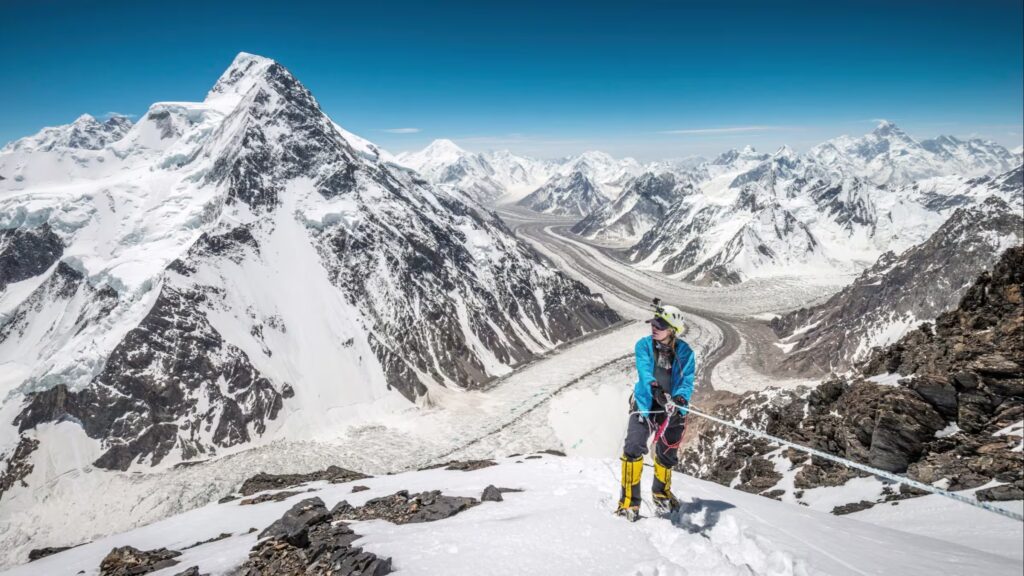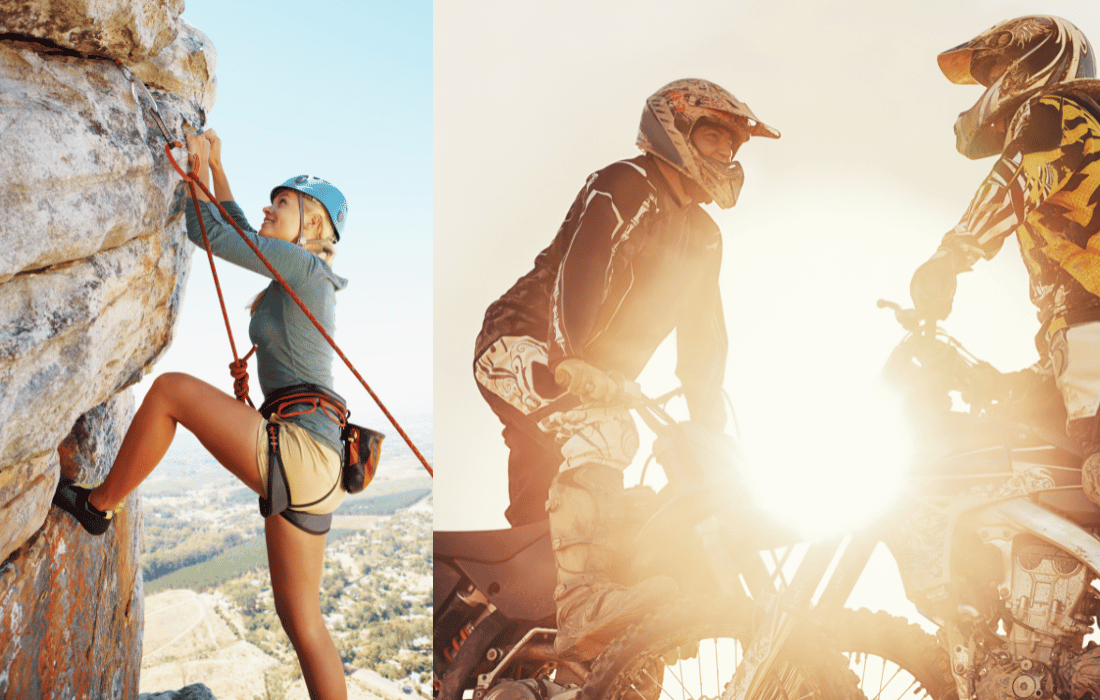Parachute, helmet, safety straps, and the roar of the engine. The anticipation builds, a final deep breath, and then the leap. This scene, repeated countless times, epitomizes the thrill-seeking spirit of many high-achieving individuals today. As more people, from CEOs to blue-collar workers, dive into extreme sports, they’re not only pursuing adrenaline but also maintaining a healthy and disciplined lifestyle that extends beyond the ordinary.
The Dual Life of Modern Thrill-Seekers
In the realm of action and combat sports, the commitment and discipline required often go far beyond what traditional sports demand. While many athletes in sports like football, baseball, and basketball may cease their rigorous training post-high school or college, those in independent sports often continue their pursuits well into adulthood. This continuation is not merely about staying active; it’s about chasing the unique thrill and maintaining a lifestyle that fosters discipline, mental toughness, and a deep connection to their sport.
Take, for example, a CEO who frequently travels for work. To prepare for a motocross race, they must meticulously train, get their bike ready, test it, and transport it to the nearest track or trail, which can be several hours away. The dirty, and sometimes painful car ride home after is often still done with a grin of satisfaction and craving for more.
In contrast, a former basketball player might consider a weekly gym session of shooting hoops as “sticking with it.” However, the dedication seen in independent sports enthusiasts is on a different level. They seek the thrill that these extreme sports provide, a feeling that goes beyond mere physical activity.
The Commitment to Fitness and Health
Pursuing these high-octane activities requires a profound commitment to fitness and health. Take Jiu-Jitsu practitioners, for example. They often juggle demanding jobs while dedicating hours to rolling on the mats, mastering techniques, and improving their physical condition. This lifestyle fosters not only physical strength but also mental resilience and a disciplined mindset.
Moreover, the rigorous demands of sports like motocross, mountain biking, or skydiving necessitate a healthy lifestyle. Regular training, proper nutrition, and injury prevention are critical. These athletes understand the importance of maintaining peak physical condition to not only perform at their best but also to prevent injuries. According to a study published in the Journal of Science and Medicine in Sport, extreme sports participants are more likely to adhere to strict training regimens and healthy diets to support their high-intensity activities.
The Thrill of the Challenge
What sets these individuals apart is their ability to balance high-pressure careers with their adrenaline-fueled passions. Men and women of all ages prioritize activities that make them feel alive. After a long day at the office, they might change into their Jiu-Jitsu gear and head to the dojo, where they spend hours rolling, trying to suffocate their sweaty friends, only to shake hands and laugh afterward. This commitment to their sport is a testament to their unique mindset and lifestyle.
The people who pursue these sports are wired differently. They thrive on the challenge, the risk, and the rush of pushing their limits. This mindset is not just about the physical aspect; it’s deeply rooted in their brain chemistry. The dopamine hits from these activities are significantly higher, providing a sense of fulfillment and joy that conventional activities might not offer.
Science Behind Fear and Dopamine Response in Extreme Sports
When we engage in extreme sports, our brains undergo a fascinating neurochemical process. The amygdala, responsible for processing fear, sends signals that trigger the release of adrenaline, preparing the body for a ‘fight or flight’ response. Concurrently, the brain releases dopamine, a neurotransmitter associated with pleasure and reward. This dopamine surge not only mitigates the fear response but also creates a feeling of euphoria. This combination of fear and pleasure is what makes extreme sports so addictive, as each thrill-seeking experience reinforces the desire for the next adrenaline rush.
In essence, the thrill of extreme sports is a delicate balance of fear and reward. The fear response heightens our senses and awareness, making every moment more intense. Meanwhile, the dopamine release provides a powerful sense of satisfaction and joy, creating a compelling cycle of anticipation and fulfillment. This neurochemical interplay explains why individuals continue to seek out extreme sports despite the inherent risks, as the unique blend of fear and pleasure offers an unparalleled sense of aliveness and accomplishment.
Injury and Recovery
With high-risk sports comes the inevitable risk of injury. However, those who participate in these sports are often more prepared to handle injuries than the average person. They prioritize injury prevention through proper training, stretching, and recovery protocols. When injuries do occur, they approach recovery with the same intensity as their training.
Travis Pastrana, an iconic figure in action sports, has sustained numerous injuries throughout his career, from broken bones to concussions. Despite these setbacks, Pastrana’s dedication to recovery, including exploring advanced treatments like stem cell therapy, highlights the resilience and determination of extreme sports athletes.
The Psychological Benefits of Extreme Sports
The psychological literature supports the notion that high-octane activities foster personal growth. The dopamine rush from extreme sports can enhance emotional well-being, offering a form of stress relief and mental clarity. For many, the bragging rights associated with these feats are equally motivating. As Grace Lordan, an associate professor of behavioral science at the London School of Economics, notes, the appeal lies in the unique stories these experiences create, making them far more captivating than typical social milestones.
Additionally, the rise in participation in extreme sports is often linked to increasing confidence and success in professional realms. High-flying individuals, accustomed to pushing boundaries at work, naturally seek similar challenges in other aspects of their lives. Kenneth Carter, a professor of clinical psychology at Emory University, points to a correlation between entrepreneurial spirit and adventure-seeking, noting that many business leaders possess a high tolerance for risk.
Breaking into a Male-Dominated World
Despite the growing interest, extreme sports remain largely male-dominated. Women like Karina Hollekim, a former professional BASE jumper, describe
Women like Karina Hollekim, a former professional BASE jumper, describe their pursuit of adrenaline as a means to gain mastery over personal fears and restlessness. This drive often leads to a continuous quest for new and exciting challenges, a phenomenon O’Brien calls “scope creep.”

Image Source: Vanessa O’Brien, who climbed K2 in 2017 © Alex Buisse
Practical challenges also play a role. Extreme sports require a certain level of technical expertise and physical fitness, which can be daunting for beginners. However, opportunities for entry-level experiences are expanding. For instance, Peter Georén co-founded Inclined Labs in Stockholm, offering wingsuit flying simulators for those without prior experience.
The Cultural Shift
The cultural landscape is gradually shifting. Historically, adrenaline sports have been perceived as male domains, often characterized by a testosterone-fueled atmosphere. However, women are steadily making inroads. Roz Shaw, operations manager for Nicholson McLaren Engines, recalls the overt chauvinism she faced when she started racing historic touring cars. Today, the environment is more inclusive, with women participating in various roles in motorsports.
High-profile figures like Betty Klimenko, the first female team owner in Australia’s Supercars Championship, have paved the way for other women. Klimenko’s success in the prestigious Bathurst 1000 race underscores the growing acceptance and respect for female participants in extreme sports.
Women-Only Adventures
The rise in female enthusiasm for extreme sports has also led to an increase in women-only adventure trips. Bespoke travel companies like Plan South America now offer exclusive experiences tailored to women, from heliskiing to wild camping. These trips provide a supportive environment, free from the lingering biases that still pervade some male-dominated activities.
The Unique Thrill of Independent Sports
In the realm of action and combat sports, the commitment and discipline required often go far beyond what traditional sports demand. While many athletes in sports like football, baseball, and basketball may cease their rigorous training post-high school or college, those in independent sports often continue their pursuits well into adulthood. This continuation is not merely about staying active; it’s about chasing the unique thrill and maintaining a lifestyle that fosters discipline, mental toughness, and a deep connection to their sport.
Balancing the Mundane with the Extraordinary
The dedication required to pursue these sports while managing a career is immense. High achievers often find themselves balancing the mundane aspects of life with extraordinary pursuits. For instance, a software engineer might spend the week coding and debugging but spends weekends cliff diving or mountain biking. This balance is not just about managing time but also about maintaining the physical and mental energy required for both worlds.
As Kenneth Carter, a professor of clinical psychology at Emory University, points out, there is a strong correlation between entrepreneurial business leaders and adventure-seeking. Many business leaders possess a high tolerance for risk, which translates into their personal lives as well.
Conclusion
As more high-achieving individuals venture into extreme sports, they not only pursue personal thrills but also challenge societal norms. The rise of people in adrenaline activities highlights a broader cultural shift towards inclusivity and empowerment. Whether it’s skydiving, BASE jumping, or mountain climbing, these individuals are redefining what it means to push boundaries, both in their professional lives and beyond.
This article serves to inspire and resonate with our readers, highlighting the unique dedication and thrill that action and combat sports enthusiasts embody. These athletes are not just participants; they are trailblazers, constantly pushing the limits of what’s possible, both on and off the field.







